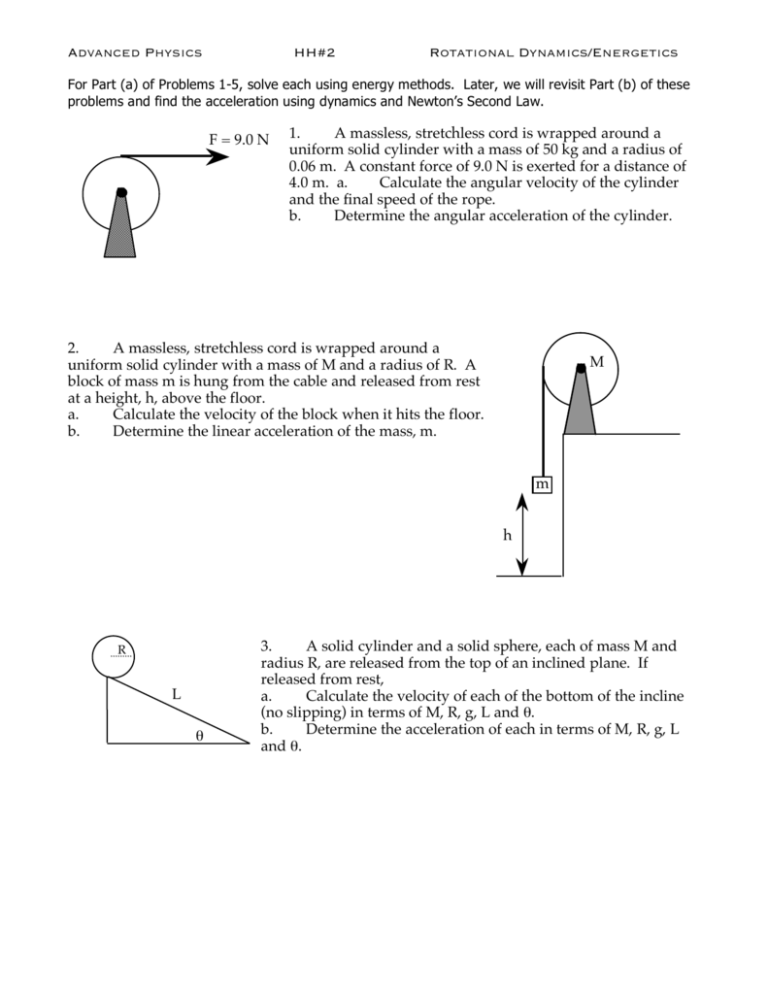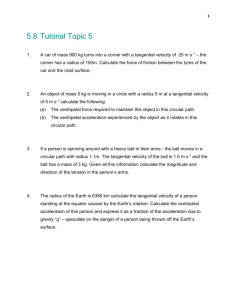Advanced Physics HH#2 Rotational Dynamics/Energetics 1. A
advertisement

Advanced Physics HH#2 Rotational Dynamics/Energetics For Part (a) of Problems 1-5, solve each using energy methods. Later, we will revisit Part (b) of these problems and find the acceleration using dynamics and Newton’s Second Law. F = 9.0 N 1. A massless, stretchless cord is wrapped around a uniform solid cylinder with a mass of 50 kg and a radius of 0.06 m. A constant force of 9.0 N is exerted for a distance of 4.0 m. a. Calculate the angular velocity of the cylinder and the final speed of the rope. b. Determine the angular acceleration of the cylinder. 2. A massless, stretchless cord is wrapped around a uniform solid cylinder with a mass of M and a radius of R. A block of mass m is hung from the cable and released from rest at a height, h, above the floor. a. Calculate the velocity of the block when it hits the floor. b. Determine the linear acceleration of the mass, m. M m h R L θ 3. A solid cylinder and a solid sphere, each of mass M and radius R, are released from the top of an inclined plane. If released from rest, a. Calculate the velocity of each of the bottom of the incline (no slipping) in terms of M, R, g, L and θ. b. Determine the acceleration of each in terms of M, R, g, L and θ. M R M 4. A solid uniform disk with a mass M and a radius R is pivoted around a horizontal axis through its center, and a small object with mass M is attached to the rim of the disk. If the disk is released from rest with the small object at the end of a horizontal radius, a. Find the angular velocity of the small object at the bottom. b. Determine the acceleration of the small object the instant it is released from rest. A mA I mB B 5. Consider the system sketched at the right. The pulley has a radius R and a moment of inertia I, The rope does not slip over the pulley. The coefficient of friction between the block A and the tabletop is µk. The system is released from rest, and the block B descends. a. Use energy methods to calculate the speed of block B after it has descended a distance, d. b. Determine the acceleration of the system. 6. A string is wrapped several times around the rim of a small thin hoop with a radius of 0.0800 m and a mass of 0.280 kg. If the free end of the string is held in place and the hoop is released from rest, calculate a. the tension in the string while the hoop descends and the string unwinds; b. the time it takes the hoop to descend 0.500 m; c. the angular velocity of the rotating hoop after it has descended 0.500 m. L m θ string M 7. A point mass, M, is affixed to the end of a uniform rod of length, L, and mass, m. One end of the rod is connected to a frictionless axis and end with the point mass is hung horizontally by means of a thread attached to the ceiling. The string is then cut. a. Find αo. b. Find ω at the bottom. c. Find the linear velocity of M at the bottom. d. Is α constant? Explain. e. Derive the expression for α as a function of θ. Express your answer in terms of θ, L, g, m, and M. Advanced Physics HH#2 KEY Rotational Dynamics/Energetics For Part (a) of Problems 1-5, solve each using energy methods. Later, we will revisit Part (b) of these problems and find the acceleration using dynamics and Newton’s Second Law. 1. A massless, stretchless cord is wrapped around a uniform solid cylinder with a mass of 50 kg and a radius of 0.06 m. A constant force of 9.0 N is exerted for a distance of 4.0 m. a. Calculate the angular velocity of the cylinder and the final speed of the rope. b. Determine the angular acceleration of the cylinder. F = 9.0 N W = F " #s|| = #KE = 12 I$ 2 T "R = I# = 12 MR 2# $ = 28.3 rad sec v = 1.7 ms # = 6.0 rads 2 ;a = R# = 0.36 m s 2 v = 1.7 m s M 2. A massless, stretchless cord is wrapped around a ! of R. A uniform solid cylinder!with a mass of M and a radius block of mass m is hung from the cable and released from rest at a height, h, above the floor. a. Calculate the velocity of the block when it hits the floor. b. Determine the linear acceleration of the mass, m. mgh = 12 mv 2 + 12 I" 2 = 12 mv 2 + 1 2 ( 1 2 # v& MR 2 )% ( $R' 2 2mgh v= m + 12 M mg " T = ma $ a' T #R = 12 MR 2 & ) %R ( mg a= m + 12 M m h v 2f = v 2o + 2ah v= ! 3. A!solid cylinder and a solid sphere, each of mass M and radius R, are released from the top of an inclined plane. If released from rest, a. Calculate the velocity of each of the bottom of the incline (no slipping) in terms of M, R, g, L and θ. b. Determine the acceleration of each in terms of M, R, g, L and θ. R L θ Mgh = 12 Mv 2 + 12 I" 2 % v (2 MgL sin# = 12 Mv 2 + 12 ( $MR 2 )' * &R ) v= ! 2mgh m + 12 M 2gL sin# 1+ $ ! & a) Mg || " Ff = Ma and Ff #R = I$ = %MR 2 ( + 'R * Solving for a : Mg sin, g sin, a= = and then get v by kinematics M + %M 1+ % M R M 4. A solid uniform disk with a mass M and a radius R is pivoted around a horizontal axis through its center, and a small object with mass M is attached to the rim of the disk. If the disk is released from rest with the small object at the end of a horizontal radius, a. Find the angular velocity of the small object at the bottom. b. Determine the acceleration of the small object the instant it is released from rest. 2 1 2 MgR = M mass v + I 2gR = 1+ 12 v= 4 3 2 2 1 2 " = Mv + 1 2 disk gR and " = 1 2 ( 1 2 #v& MR )% ( $R ' 2 v R 2 " = I# Mg $ R = (MR 2 + 12 MR 2 ) a= a R g = 2g 1+ 12 3 ! ! A mA I mB B 5. Consider the system sketched at the right. The pulley has a radius R and a moment of inertia I, the rope does not slip over the pulley. The coefficient of friction between the block A and the tabletop is µk. The system is released from rest, and the block B descends. a. Use energy methods to calculate the speed of block B after it has descended a distance, d. b. Determine the acceleration of the system. TE final = TE original " WFf 1 2 m B v 2 + 12 m A v 2 + 12 I# 2 = m Bgd " µm Agd v= a= 2( m Bgd " µm Agd) mB g " µmA g mA + mB + RI2 m A + m B + RI2 ! 6. A string! is wrapped several times around the rim of a small thin hoop with a radius of 0.0800 m and a mass of 0.280 kg. If the free end of the string is held in place and the hoop is released from rest, calculate a. the tension in the string while the hoop descends and the string unwinds; b. the time it takes the hoop to descend 0.500 m; c. the angular velocity of the rotating hoop after it has descended 0.500 m. $a' a) Mg " T = Ma and T # R = MR 2 & ) %R ( a = 5 m s 2 and T = 1.4N b) t = 0.45 sec c) v = 5; * = 28 rad s ! L m θ string M 7. A point mass, M, is affixed to the end of a uniform rod of length, L, and mass, m. One end of the rod is connected to a frictionless axis and end with the point mass is hung horizontally by means of a thread attached to the ceiling. The string is then cut. a. Find αo. b. Find ω at the bottom. c. Find the linear velocity of M at the bottom. d. Is α constant? Explain. e. Derive the expression for α as a function of θ. Express your answer in terms of θ, L, g, m, and M. a) By torque : #L& mg " % ( + Mg "L = ( 13 mL2 + ML2 ))o $ 2' b) By Energy : #L & mg% ( + MgL = 12 ( 13 mL2 + ML2 )* 2 $ 2' c) v = L" d) No, torque is not constant so neither is # mgL cos$ + MgL cos$ 2 e) # = 2 ( 13 mL + ML2 ) ! !





